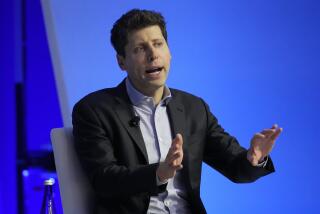Book Review : Testing Limits of Artificial Intelligence
- Share via
Machinery of the Mind: Inside the New Science of Artificial Intelligence by George Johnson (Times Books: $19.95)
The process by which writers convey their thoughts to readers is endlessly intriguing. How does it work? The writer has an idea--the thought. He manipulates his fingers to type this thought on a keyboard. Eventually, this physical act is turned into a plate on a printing press, which uses it to put ink on paper. The reader reads these physical marks (letters), and the writer’s thought is recreated in his mind.
But what is the thought made of? Is it purely physical? Is it “just” a complex electro-chemical state of the brain, far beyond our current ability to describe, but a describable physical state nonetheless? If so, it should be possible to duplicate this purely physical phenomenon artificially--in a computer, perhaps.
Or is there something more to a thought, some aspect that cannot be reduced to a physical description of the brain? If so, how does this “non-physical” part get translated into the purely physical acts of typing and printing, and how does it get translated back again into a “non-physical” thought in the reader’s brain?
The Central Issue
This is a modern version of the mind-body problem that occupied Descartes in the 17th Century: How does the soul, or mind, which is not physical, interact with the body, a purely mechanical device? The question is also the central issue in today’s debate over artificial intelligence, the effort to make computers think like people.
Few developments of contemporary science have been the object of as much hype. Proponents and those out to make a buck proclaim that artificial intelligence is already a reality, an assertion unsupported by fact. There have been many claims for artificial intelligence over the last 30 years, but few have been realized. The tasks that humans find easiest, such as seeing, talking, picking up objects and understanding spoken language, computers can still hardly do at all.
Curiously, as George Johnson, a science writer, notes in “Machinery of the Mind,” computers do much better at some human tasks that require higher-level thought. Chess, for example. The best computer chess programs can beat all but a few of the world’s best chess players.
Not by Cleverness
But they do it by brute force and not by cleverness, not by scanning the pattern on the board and unconsciously “seeing” the right move, as human champions do. Lightening-fast computers consider and discard thousands of possible moves that the human doesn’t even think about.
Is there a way to specify exactly what the human brain does when it is thinking? This is the central challenge to artificial intelligence, and in some ways, it is a central challenge to modern science. Either the world is understandable and describable, as science claims, or it isn’t.
For more than three centuries, the scientific method has demonstrated the power of reason and knowledge. It has transformed the world and continues to change it at an accelerating rate. In particular, everything that modern biology has learned about the human body says that it is a physical object and no more. There is no elan vital , no life spirit that animates the flesh and blood.
But when it comes to the brain, there is still a debate. The members of the artificial intelligentsia--and they are many--insist that anything that can be described can be programmed into a computer and that eventually machines can be made to think.
The other side, which includes the Berkeley philosophers John Searle and Hubert Dreyfus, insist just as strongly that there is “something more” to thinking than computers can ever do, some aspect that can never be adequately described.
Johnson’s book is a status report on artificial intelligence. It accurately portrays the state of the art in a field that combines electrical engineering with psychology to produce something like applied philosophy. He perhaps devotes too much space at the beginning to laying the groundwork--how computers work, that sort of thing--and there may be one too many digressions along the way. But this is a solid, well-researched, honest piece of work.
Johnson has done a good job of reporting the facts and conveying them in a way that should satisfy both experts and laymen. This is no mean task. He is sensitive to the deep philosophical issues that bear on the subject, part of what makes it so enticing. He gives a good account of the people involved in this work, their personalities and their disagreements.
Radical Criticism
But he doesn’t take the criticism seriously enough. The difficulties of achieving artificial intelligence, the seemingly insurmountable hurdles, are discussed throughout the book. But almost always with a tone of, “In time, this, too, shall fall.” The radical criticism of Searle and Dreyfus doesn’t appear until near the end. It would have done better at the beginning, where it could have served as the backdrop for the ensuing discussion.
One of Dreyfus’ strongest arguments is that artificial intelligence has achieved a modicum of success only where the task it is called on to perform is strictly and narrowly defined.
For example, computers have been made that understand a limited vocabulary of words spoken individually by a speaker that the machine has been trained to hear. But no one knows how to make one that can understand continuous speech with an unlimited vocabulary by any speaker of the language--something that people do without effort.
Dreyfus contends that the techniques of artificial intelligence cannot be expanded to produce a machine that thinks, just as you can’t fly to the moon by learning to climb trees.
Johnson’s descriptions of the work of artificial intelligence repeatedly make this point. Sufficiently restrict the problem, and the machine can take a stab at it. Open it up, and the machine can’t.
Everyone agrees that the present methods are inadequate, but no one knows where a breakthrough might come from. Dreyfus et al say that no breakthrough is possible.
The mind is characterized by flexibility, common sense, judgment and the ability to make connections between unconnected things. Computers do not now possess any of these traits, and they are unlikely to in the foreseeable future. The question of whether the task is inherently impossible is a serious one, and it could profitably be considered before Chapter 13 of a 15-chapter book.
More to Read
Sign up for our Book Club newsletter
Get the latest news, events and more from the Los Angeles Times Book Club, and help us get L.A. reading and talking.
You may occasionally receive promotional content from the Los Angeles Times.










